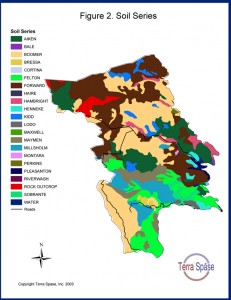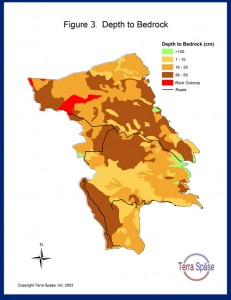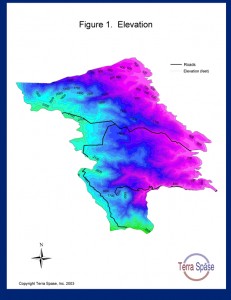Our Appellation
Paul W. Skinner, Ph.D*.
Terra Spase, Inc.
The terroir of Spring Mountain vineyards is defined by a diverse topography, climate, and collection of soils that are unique to this Napa Valley appellation. Vineyards within the Spring Mountain Appellation reflect this diversity with their varied selection of wine grape varietals, rootstocks, row and vine spacing, and trellis designs. The wines made from Spring Mountain vineyards collectively showcase this diversity in their varietal complexity, intensity and age-worthiness.
Topography
Spring Mountain Appellation straddles the northern and eastern slopes of the Mayacamas mountain range at elevations ranging from 400 to approximately 2,100 feet. The area of highest elevation is at the western boundary of the appellation, while the lowest elevations are at the eastern and south central boundaries (Figure 1). The area of highest elevation near the Sonoma county line consists of predominantly the Aiken, Forward, and Boomer soil series. The areas of lower elevation are predominantly the Felton, Millsholm and Hambright series.
The general slope of the Mayacamas range in the Spring Mountain Appellation is from west to east; however, the deeply incised drainages of York and Sulphur Creeks result in slopes with south, west and north aspects. The differences in slope, aspect and elevation have important effects on vineyard design and the grapes produced. Vineyards planted to the same variety and rootstock with the same spacing, training and trellis system can vary with respect to both yield and fruit composition depending on vineyard elevation, slope and aspect.
Soils
 The parent materials for the soils of the Spring Mountain Appellation were derived primarily from weathered volcanic materials and sedimentary rock. The Boomer soil series makes up approximately 26 % of the appellation, while the Forward and Aiken soils are 26 % and 12 % respectively (Figure 2). These and most of the soils in the northern half of the appellation were derived from volcanic parent material. The lower elevations found in the southern half of the appellation contain large areas of the Felton, Millsholm and Sobrante series, which were formed from sandstone and shale parent materials.
The parent materials for the soils of the Spring Mountain Appellation were derived primarily from weathered volcanic materials and sedimentary rock. The Boomer soil series makes up approximately 26 % of the appellation, while the Forward and Aiken soils are 26 % and 12 % respectively (Figure 2). These and most of the soils in the northern half of the appellation were derived from volcanic parent material. The lower elevations found in the southern half of the appellation contain large areas of the Felton, Millsholm and Sobrante series, which were formed from sandstone and shale parent materials.
The depth of the soils to bedrock varies from a low of 6 inches to a high of 40 inches in the Millsholm and Boomer series respectively (Figure 3). A large percentage of the soils present in the appellation are less than 20 inches deep. Available water holding capacity varies with soil depth and is extremely important in determining irrigation requirements throughout the growing season.
 The soils of Spring Mountain are predominantly well drained and vineyards often require supplemental irrigations during the summer and preharvest seasons. There are many natural springs scattered throughout the appellation that can contribute significant amounts of water to specific vineyards.
The soils of Spring Mountain are predominantly well drained and vineyards often require supplemental irrigations during the summer and preharvest seasons. There are many natural springs scattered throughout the appellation that can contribute significant amounts of water to specific vineyards.
Soil pH is typically acidic, and calcium/magnesium ratios can oftentimes be greater than 2.0. Soil magnesium and phosphorus levels are typically low due to the acidic pH, presence of kaolinite clay minerals, and the influence of the mixed mineralogy of the parent material. Nutrients and water are usually carefully monitored in Spring Mountain Vineyards because of their important effects on vine fruitfulness, canopy health, and fruit ripening.
Climate
The climate on Spring Mountain is characterized by high winter rainfall (25 to 95 inches) and low summer rainfall (< 1.0 inch). Springtime temperatures are generally cooler at the higher elevations and warmer at the lower elevations. The mean maximum summertime temperatures ranged from 81 to 97 degrees during the 1996 to 2002 growing seasons, a range somewhat lower than the mean maximum temperatures recorded on the valley floor during the same time period.
 Mid-summer and early autumn temperatures are dramatically affected by the marine layers from San Pablo Bay and the Pacific Coast. The marine layers tend to moderate the maximum and minimum temperatures recorded within the Spring Mountain appellation during this time period. The combination of relatively cool days and warm nights is somewhat opposite to the warm to hot days and cool nights found in the nearby valley floor appellations. Mean temperatures during the ripening months of September and October vary from 64 to 71 degrees in September, and 59 to 65 in October. This range is considered ideal for ripening most wine grape varieties.
Mid-summer and early autumn temperatures are dramatically affected by the marine layers from San Pablo Bay and the Pacific Coast. The marine layers tend to moderate the maximum and minimum temperatures recorded within the Spring Mountain appellation during this time period. The combination of relatively cool days and warm nights is somewhat opposite to the warm to hot days and cool nights found in the nearby valley floor appellations. Mean temperatures during the ripening months of September and October vary from 64 to 71 degrees in September, and 59 to 65 in October. This range is considered ideal for ripening most wine grape varieties.
Since 1996, growing degree days ranged from a low of 3,100 in 1998 to a high of 4,200 in 1997 and 2001. This corresponds to a Region III in 1998 to a Region V in 2001, with the general trend being a Region III to IV during the past seven growing seasons.
Vineyards
Vineyards on the weathered volcanic and sedimentary soils of the Spring Mountain Appellation are usually planted to drought resistant rootstocks and trained to bilateral cordons with a vertical shoot positioned trellis. There is no one training and trellis system, however, that works on Spring Mountain. At present there exist both old, head-trained vineyards and vineyards on AXR rootstock with a California sprawl T-trellis. There are also newer vineyards on a quadrilateral divided trellis and on closely spaced vertical shoot positioned systems. All of these vineyards are capable of producing exceptional quality fruit if the vines are balanced between their crop load and vegetative growth.
Spring Mountain produces both premium red and white wine grape varietals, including Chardonnay, Viognier, Cabernet Franc, Merlot, and Cabernet Sauvignon. Smaller acreages of Riesling, Pinot Noir, Zinfandel, Syrah, Petite Verdot and Malbec are also known for producing exceptional quality fruit and wines.
The combination of low vigor potential soils with high winter rainfalls, cool springtime temperatures, and warm nighttime harvest temperatures produces a highly variable yet unique environment for premium wine grape growing within the Napa Valley AVA. Spring Mountain vineyards are known for their moderate production of grapes and wines with intense varietal fruit character and complex mountain tannins that differentiate them from the wines of other appellations in the premium wine-producing world.
About Paul W. Skinner, Ph.D., Terra Spase, Inc.
Paul has been consulting with wine grape growers in the Napa Valley and beyond since completing his Ph.D. in Soil Science at UC Davis in 1988. His thesis, entitled Phosphorus nutrition of wine grapes, characterized and illuminated a serious growth limiting condition for mountain vineyards.
He recently authored Soils and Wine Grapes in the Napa Valley AVA and Weather and Wine Grapes in the Napa Valley AVA ,the most recent in-depth scientific works on the subjects. Both are available at: www.terraspase.com.
Over the years, Paul has consulted for a number of vineyards on Spring Mountain, including Pride Mountain Vineyards, Paloma Vineyard, Cain, Draper, Philip Togni Vineyards, Sherwin Family Vineyards, Spring Mountain Vineyards, Terra Valentine, and Ballard Family Vineyards.

